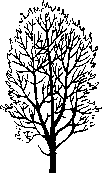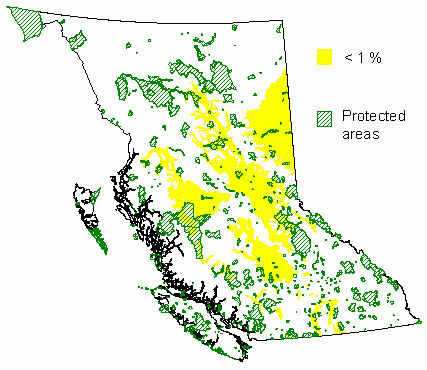 Pin cherry
Pin cherry
Prunus pennsylvanica L. f.
Introduction
Pin cherry is a small, common tree found in a great variety of habitats in Canada and the northern United States. It is sometimes called fire cherry for its natural reforestation ability after forest fires, or bird cherry for the value of the cherries as bird food. It forms pure stands that provide shade for seedlings of slower growing, shade tolerant species, then dies off, making way for the new trees. Its life span is short: about 30 years. Pin cherry is classed as very intolerant of shade. Many insects and diseases attack pin cherry (Burns and Honkala 1990). It has some potential as a future native horticultural crop (St. Pierre 1992). Coumarin in leaves and bark may confer resistance to certain diseases and because of the presence of these chemical compounds (Santamour and Riedel 1994), wild cherry may have some importance for cherry breeding. The bark of pin cherry was used widely by first peoples to make baskets and for wrapping food (Turner 1979).
The range of pin cherry is huge and mostly northern. It extends from Newfoundland to British Columbia and southeast to Pennsylvania, with scattered areas occurring even further south. In British Columbia, pin cherry is common in the central Cordilleran region at low elevation (Little 1976; Little 1977; Burns and Honkala 1990).
Distribution and Protected Areas – from Hamann et.al. 2005



Conservation Status Summary – from Chourmouzis et.al. 2009
“In central British Columbia, pin cherry is well protected in the IDF zone. However, in the SBS zone, in the core of its British Columbia range, pin cherry is protected only at threshold values below 10 hectares cumulative cover (the threshold deemed adequate for large trees to conserve adequate population sizes). Ground truthing is recommended first in the SBS zone, and then in the BWBS and ICH zones.”
Reproduction
Pin cherry produces a large number of fruits, which are dispersed by gravity and to a lesser degree by birds and small mammals. Good fruit crops occur annually (Banerjee et al. 2001). It has been estimated that some seeds buried in the soil retain their viability for 50 to 150 years (Marks 1971; Graber and Thompson 1978). A small amount of pin cherry seed probably germinates annually in northern hardwood stands. The largest number of pin cherry seedlings appeared in response to major disturbances such as heavy cutting or burning (Marks 1974). Pin cherry readily reproduces vegetatively by root suckers (Burns and Honkala 1990).
Genetic structure
Pin cherry hybridizes with bitter cherry (Prunus emarginata) (Taylor and Taylor 1981).
Resource management and seed transfer
No information available.
REFERENCES
Hamann, A., Smets, P., Aitken, S. N. and Yanchuk, A. D. 2005. An ecogeographic framework for in situ conservation of forest trees in British Columbia. Can. J. For. Res. 35:2553-2561. View online resources for this report.
C. Chourmouzis, A.D. Yanchuk, A. Hamann, P. Smets, and S.N. Aitken. 2009. Forest Tree Genetic Conservation Status Report 1: In situ conservation status of all indigenous BC species. Centre for Forest Conservation Genetics, Forest Genetics Council of BC, and BC Ministry of Forests and Range, Forest Science Program, Victoria, BC Technical Report 053. www.for.gov.bc.ca/hfd/pubs/Docs/Tr/Tr053.htm
Banerjee, S. M., Creasy, K. and Gertzen, D. D. 2001. Native woody plant seed collection guide for British Columbia. Crown Publications, Victoria. 147 p.
Burns, R. M. and Honkala, B. H. 1990. Silvics of North America vol 2. Agriculture handbook 654. U.S. Dept. of Agriculture Forest Service, Washington, D.C. 877 p.
Graber, R. E. and Thompson, D. F. 1978. Seeds in the organic layers and soil of four beech-birch-maple stands. USDA Forest Service, Research Paper NE-401. 8 p.
Little, E. L., Jr. 1976. Atlas of United States trees, volume 3, minor western hardwoods. U.S. Department of Agriculture Miscellaneous Publication 1314. 13 p., 290 maps.
Little, E. L., Jr. 1977. Atlas of United States trees, volume 4, minor eastern hardwoods. U.S. Department of Agriculture Miscellaneous Publication 1342. 17 p., 230 maps.
Marks, P. L. 1971. The role of Prunus pensylvanica L. in the rapid revegetation of disturbed sites. Ph.D. thesis. Yale University, New Haven, CT, 119 p.
Marks, P. L. 1974. The role of pin cherry (Prunus pensylvanica L.) in the maintenance of stability in northern hardwood ecosystems. Ecological Monographs 44:73-88.
Santamour, F. S. J. and Riedel, L. G. H. 1994. Distribution and inheritance of scopolin and herniarin in some Prunus species. Biochemical Systematics & Ecology 22:197-201.
St. Pierre, R. G. 1992. The development of native fruit species as horticultural crops in Saskatchewan. Hortscience 27:866-947.
Taylor, R. L. and Taylor, S. 1981. Prunus emarginata in British Columbia: bitter cherry, member of the family Rosaceae. Description, cultivation, ornamental and landscape plant. Davidsonia 12:78-83.
Turner, N. J. 1979. Plants in British Columbia Indian technology. B.C. Provincial Museum Handbook no. 38. BC Provincial Museum, Victoria, B.C. 304 p.
